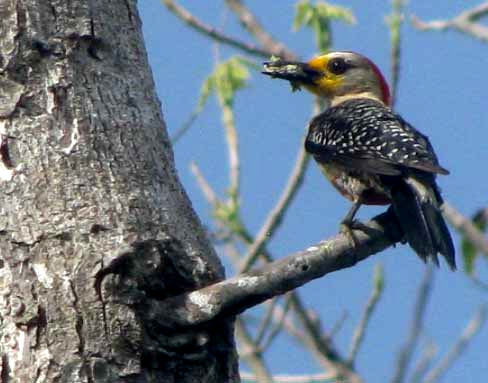Excerpts from Jim Conrad's
Naturalist Newsletter
from the June 19, 2011 Newsletter issued from Mayan Beach Garden Inn 20 kms north of Mahahual; Caribbean coastal beach and mangroves, ~N18.89°, ~W87.64°, Quintana Roo state, MÉXICO
YUCATAN WOODPECKERS
For birders visiting the Yucatán usually the most cherished sightings are those of endemic species -- species occurring naturally nowhere else on Earth. In the bioregion comprising the Yucatan Peninsula, parts of Belize, northern Guatemala and western Tabasco, about 14 bird species are recognized as endemic. One of those is the Yucatan Woodpecker, CENTURUS PYGMAEUS.
Before coming here I'd only seen Yucatan Woodpeckers once before -- in arid coastal scrub near Río Lagartos in the northern Yucatán. Here I've seen several. A picture of one with a beakful of grubs is shown below:

That bird displays much more yellow around the base of its beak than do illustrations of the species in field guides. Typically Yucatan Woodpeckers are shown with small, yellow "nasal tufts" at the base of the top of the bill. Is the pictured individual atypical, or are the faces of some Yucatan Woodpeckers simply more yellow than the books show? Two more pictures appear below:

In that picture I'm not sure whether we have two different birds or one bird shot twice. Both images were taken at the same hole but on different days. Whatever the case, both pictures show birds with much more facial yellow than field guides do. On the Internet I find a few more such yellow-faced Yucatan Woodpeckers so ours aren't just birds who have stained their faces by eating something yellow.
Up at Hacienda Chichen so often I've seen Golden-fronted Woodpeckers identified as Yucatan Woodpeckers that it's worth dwelling on the differences between the two species. First, a Golden-fronted is shown at www.backyardnature.net/yucatan/wp-g-f.htm.
The Golden-fronted Woodpecker is the very common red-headed woodpecker with narrow zebra barring across the back occurring throughout the Yucatán and far beyond, while Yucatan Woodpeckers are much less in evidence, or completely absent. I'm guessing that here we have ten Golden-fronteds for each Yucatan. My impression is that Yucatan Woodpeckers require less disturbed habitat than Golden-fronteds.
Yucatan Woodpeckers at 6.7 inches long (17cm) are significantly smaller than Golden-fronteds, at 9.8 inches (25cm). The Yucatan's beak is proportionately shorter than the Golden-fronted's, plus the Yucatan in flight displays a more spherical or compact, darker body. Even with these distinctions, though, under field conditions often what you think are Yucatans turn out to be Golden-fronteds -- unless you see yellow at the beak's base.
The Yucatan and Golden-fronted Woodpeckers are members of a cluster of similar species. In Mexico there's also the Gila, Golden-cheeked, Gray-breasted and then in the eastern US there's the very common Red-bellied Woodpecker. More species in the cluster occur farther south. Clearly, at some point in evolutionary history Nature came up with an especially effective "woodpecker theme," part of which was the red-headed, zebra-barred-back combination, and now that theme is being refined with local variations.
What a pleasure to be in the field experiencing these "variations on a theme."